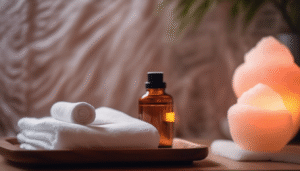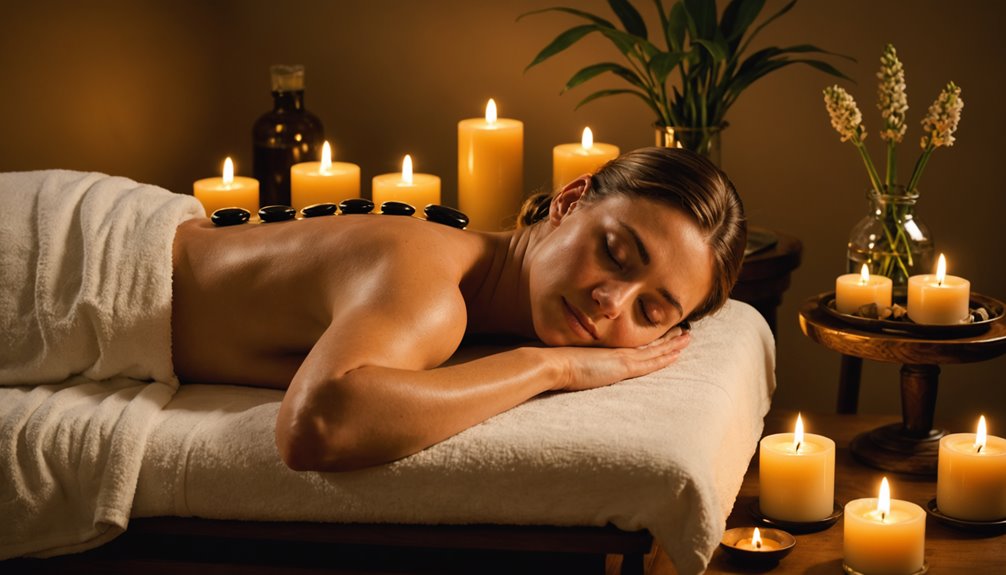To enhance your Swedish massage experience, create a serene environment with soft lighting, soothing music, and calming scents, such as lavender. Communicate your pressure preferences and areas of focus to your therapist. Synchronize your breath with the strokes using slow, deep breathing to deepen relaxation.
Warm compresses or blankets can soothe tense muscles, while staying hydrated afterward helps your body recover. Embracing these techniques enhances relaxation, emotional balance, and physical ease—explore further to discover even greater benefits.
Key Takeaways
- Create a calming environment with soft lighting, gentle music, and soothing aromatherapy, such as lavender or peppermint oils.
- Communicate your preferred pressure and areas of focus to customize and enhance the effectiveness of your massages.
- Practice slow, diaphragmatic breathing in sync with massage strokes to deepen relaxation and foster a mind-body connection.
- Use warm compresses or heated blankets during the session to soothe muscles and prolong comfort.
- Hydrate well and engage in gentle relaxation activities after the massage to support recovery and toxin elimination.
Preparing the Perfect Environment for Your Massage
Creating the perfect environment for your Swedish massage begins with carefully designing the room to strike a balance between comfort, functionality, and tranquility. You’ll want a room layout of at least 13 square meters, allowing ample space—about 90 cm around the massage table—for smooth, unhindered movement. Position the table centrally with its head farthest from the entrance to improve your sense of security.
Pay close attention to lighting ambiance: use dimmable, soft lights to foster relaxation, complemented by subtle decor that soothes without distraction. Incorporate calming elements, such as gentle music and aromatherapy, to enhance your comfort. Using low light helps create a relaxing environment while still having bright options available for practical tasks and lighting.
Another powerful benefit of the massage environment is its ability to lower cortisol levels in the body, a crucial element for proper rest and restoration. A well-designed room layout, paired with calming lighting, helps create a peaceful and welcoming space where you feel completely at ease. This thoughtful atmosphere sets the perfect stage for a deeply restorative Swedish massage experience.
Once you’ve created the perfect atmosphere for your Swedish massage, it’s crucial to understand the key techniques that make this therapy effective. Swedish methods, such as effleurage, use long, flowing strokes to gently warm your muscles, enhancing muscle relaxation and preparing the tissues for deeper work. Research indicates that massage therapy can reduce inflammatory responses, further enhancing the overall benefits of the session.

Although Swedish massage primarily targets physical tension, its mental and emotional benefits are likewise profound and life-changing.When you engage in regular sessions, you tap into powerful mindfulness practices that calm your mind and enhance emotional awareness. This calm, mindful state helps you release stress and worry, making it easier to manage your emotions healthily.
Hypnotic strokes promote the release of oxytocin and endorphins, which will uplift your mood and foster relaxation. Your license improved emotional balance as your mind connection strengthens, enabling you to cope with life’s challenges. Swedish massage doesn’t soothe your muscles; it nurtures your mental clarity and emotional resilience, inviting you to feel seen, supported, and truly at peace within yourself.
Regular therapy sessions also help activate the parasympathetic nervous system, deepening relaxation and reducing stress levels. Additionally, incorporating techniques such as ischemic compression can enhance the overall effectiveness of your massage experience.
Physical Benefits You Can Expect
 While Swedish massage is known for its mental and emotional benefits, you’ll experience significant physical benefits that boost your overall well-being. You’ll experience adequate pain relief as massage techniques reduce muscle tension and decrease inflammation, often surpassing the effects of medication for conditions such as lower back pain. As your muscles relax and stiffness diminish, your improved flexibility becomes evident, making daily movements easier and more comfortable.
While Swedish massage is known for its mental and emotional benefits, you’ll experience significant physical benefits that boost your overall well-being. You’ll experience adequate pain relief as massage techniques reduce muscle tension and decrease inflammation, often surpassing the effects of medication for conditions such as lower back pain. As your muscles relax and stiffness diminish, your improved flexibility becomes evident, making daily movements easier and more comfortable.
Improved blood circulation delivers oxygen and nutrients to your tissues, accelerating healing and waste removal, which supports detoxification and immune function. Assage may also temporarily alleviate pain and is recommended for relief from low back pain, neck pain, and shoulder pain.
Additionally, the application of deep tissue massage techniques can further enhance the benefits by targeting chronic tension and promoting healing. Every time, these benefits combine to increase your joint mobility and muscle elasticity, allowing you to move more freely and with less discomfort. Regular sessions help you maintain these physical advantages, promoting a healthier and more resilient body.
Enhancing Relaxation With Aromatherapy and Warm Therapy

When you combine aromatherapy and warm therapy with Swedish massage, you improve relaxation on multiple levels. Selecting the right essential oil tailored to your mood can enhance stress relief and boost your comfort. Aromatherapy includes improved circulation and enhanced massage effectiveness.
Techniques create a holistic experience that nurtures both body and mind, inviting you to unwind fully. Inhaling the aromatic molecules of a massage can also positively affect the brain’s limbic system, enhancing emotional well-being, as well as the impact on the olfactory system.
Consider these improvements to optimize your relaxation:
- Select calming oils like lavender or invigorating peppermint based on your preference
- Use warm compresses or heated blankets to soothe tense muscles
- Communicate with your therapist to customize pressure and aroma choices
- Maintain a comfortably warm room temperature to support lasting relaxation
This collaboration fosters a sense of belonging in a shared space of well-being and calm.
The Role of Music and Breathing in Deepening Relaxation
To deepen your relaxation during a Swedish massage, choose soothing background music that feels calming and steady. Focus on slow, rhythmic breathing and massage to soothe your nervous system and enhance your massage therapist’s skills. Ry syncing your breath with the therapist’s creates a harmonious flow that elevates peacefulness.
Choosing Soothing Background Music
Since your goal is to deepen relaxation during a Swedish massage, selecting the right background music plays a crucial role in achieving this. The perfect playlist eases your mind, syncs your heart rate, and creates an inviting atmosphere that welcomes calm. Consider these key factors for an ideal experience:
- Choose soothing music genres, such as traditional Asian instrumentals or classical piano, to promote tranquility.
- Opt for a playlist duration that offers long, uninterrupted tracks, ensuring seamless ambiance without distractions.
- Keep the tempo steady around 60-65 BPM to naturally align with your resting heart rhythm.
- Maintain soft volume levels so music improves rather than interrupts your peace.
Breathing Techniques for Calm
Selecting the right background music sets the tone, but your breath ultimately guides the depth of calm during a Swedish massage. Focusing on breath awareness helps you stay present, turning the massage into a powerful mindfulness practice. Calming music gently slows your breathing; you can deepen relaxation by consciously engaging in diaphragmatic or paced, slow breathing.
It not only reduces muscle tension but also lowers heart rate and stress, thereby enhancing the therapeutic benefits of the massage. Breathe in and breathe out creates an intimate, grounding connection within the soothing atmosphere that music provides. Together, they invite a multisensory experience where body and mind unite in calm.
Rust this simple, mindful breath focus to deepen your sense of belonging and peace throughout your massage experience.
Synchronizing Breath With Strokes
When you synchronize your breath with massage strokes, you create a harmonious rhythm that deepens relaxation and intensifies the body’s sensations. Breath alignment improves your body’s connection to the massage flow, fostering a calming parasympathetic response. Our therapist may even guide your breathing or breathe along to amplify this shared harmony, making the experience distinctly individual.
- Aligning your breath with the awareness
- Embracing soft music that complements your breathing rhythm for a more profound calm
- Actively participating in breath exercises to release tension and stress
- Noticing how breath alignment promotes sentimental release and comprehensive well-being
Together, these elements help you entirely immerse yourself in the present moment and optimize your Swedish massage experience.
Essential Post-Massage Care Practices
Although the massage itself offers significant relief, how you care for your body afterward plays a crucial role in maximizing those benefits. Start by adopting hydration strategies, such as drinking plenty of water, to flush out toxins and support muscle recovery. Pair this with gentle relaxation activities, such as mindfulness or quiet stretching, to help your muscles fully unwind.
Avoid strenuous exercise to prevent strain and allow your body to shift smoothly from massage-induced ease. Nourish y urself with balanced meals rich in nutrients that support repair and prolong relaxation. Prioritize restful sleep to improve recovery and sustain the calming effects.
By adopting these thoughtful post-massage practices, you create a supportive environment for both your body and mind, ensuring you carry that renewed sense of well-being well beyond the session.
Frequently Asked Questions
Can Swedish Massage Help With Chronic Migraines?
You can find chronic migraine relief with Swedish massage, as massage therapy benefits include reducing muscle tension and stress. Many feel a sense of belonging through regular sessions that support your holistic migraine management path.
Are There Risks for Pregnant Women Receiving Swedish Massage?
You should take pregnancy precautions with Swedish massage, particularly if you don’t have high blood pressure or clotting risks. However, don’t worry; massage benefits include pain relief, reduced swelling, and psychological support during pregnancy.
How long does a typical Swedish massage session last?
Most Swedish massage sessions last between 60 and 90 minutes. How often you go also makes a difference. You can choose what feels right for your body and schedule, ensuring each visit helps you relax, feel better, and truly feel cared for.
What Should I Do if I Feel Pain During the Massage?
If you feel pain during your massage, use clear communication techniques to alert your therapist immediately. Pain management is key—request gentler pressure or alternative methods to ensure your comfort and safety throughout the session.
Can I Eat Before a Swedish Massage Session?
You can enjoy light pre-massage snacks 1-2 hours before your session to respect digestive considerations. This helps you stay comfortable and relaxed, avoiding heaviness while maintaining energy for the full benefits of your massage.
Conclusion
By creating the perfect environment and using key Swedish massage techniques, incorporating aromatherapy or warm therapy, you’re setting the stage for deep relaxation. Did you know that 90% of people report reduced stress after just one massage session? This demo strates the impact that treatments can have on both your mind and body.
You’ll care for you. You’ll experience the benefits of massage long after your session ends.

